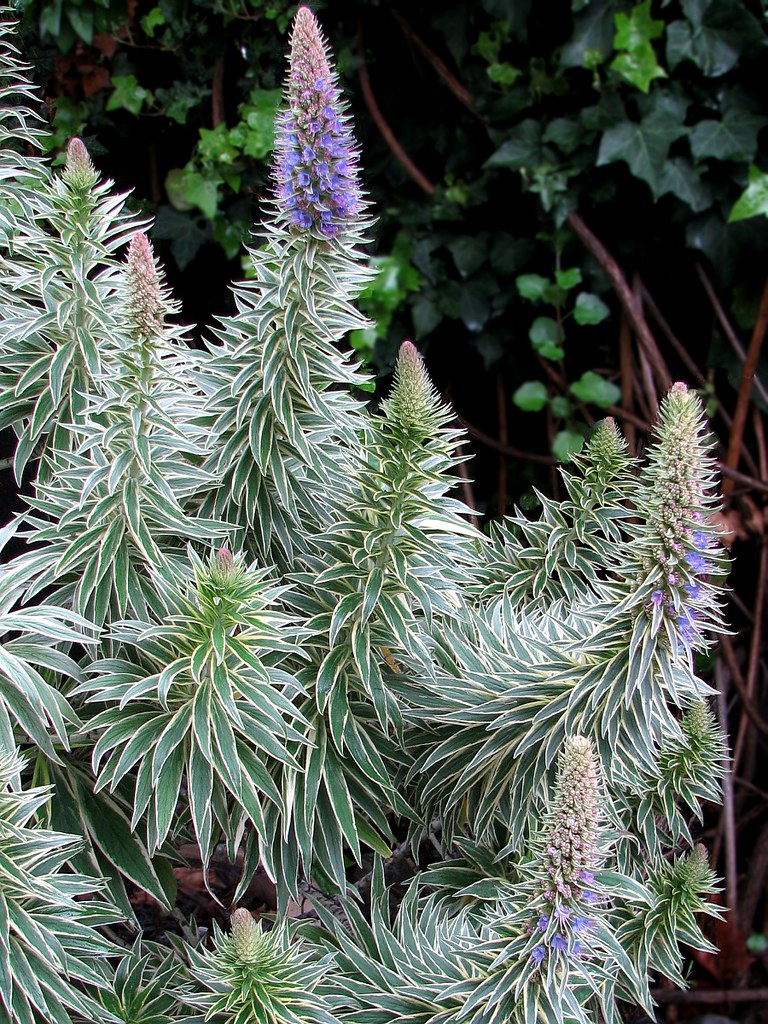This beautiful variegated Echerveria is named for the Sonoma gardener in whose garden it was originally discovered. When this plant made it to the UK, it was given the name 'Compton Carousel'. Also distributed under 'Serenity' and 'DS2009'.
Echeverias make a great groundcovers under shrubs and tall perennials - they appreciate the partial shade and their shallow roots do not compete with their companions.
Saturday, June 18, 2011
Friday, May 6, 2011
An MGS No. Calif. Branch Advisory Board day in the Botanical Gardens at UC Berkeley. African Hill was beautiful.
The apricot flowers in the foreground are Tritonia gladiolaris (syn. T. lineata), which I grow in a pot in my garden. A beautiful and easy bulb that grows over winter, flowers in spring, and then is fully dormant through our dry summer - can't get much easier!
Labels:
2011,
african hill,
berkeley,
botanica,
garden,
gladiolaris,
lineata,
may,
mgs,
tritonia
Wednesday, March 16, 2011
Variegated Echium candicans
Also called by some E. fastuosum, this shrubby perennial from the Madeira Islands is no stranger to our gardens here in California, but variegated foliage forms have become quite popular in this area of late. This clone I received from Kathy Echols, a local well-known plants woman, who selected it personally out of a large batch of variegated variants. I don't recall her given it a name. We grow this one in a large pot by our garden gate so we can enjoy it even when it is out of bloom, but this is a special moment with the spikes start to elongate and flowers color up.
Wednesday, January 19, 2011
Ruscus hypoglossum with male flowers
. . . or possibly R. ×microglossus (a hybrid of R. hypoglossum with R. hypophyllum).
I'm still trying to figure out the true identity of this plant. Not often seen around here but when it is, it seems to usually be this particular clone. Note the flowers sprouting from the center of each leaf – not actually a leaf but a flattened stem (botanically a cladode or phylloclade), which helps explain the flower position. I assume this plant is male (the plant is dioecious, with male plants and female plants) as the flowers seem to contain only anthers and no fruits are ever produced. You can see a pale new shoot emerging, showing is kinship with Asparagus. Most botanists include these plants in the order Asparagales, some in the family Asparagaceae. Still others place it in the same order/family but in the subfamily Nolinoideae. It has even given its name to a separate family – the Ruscaceae (who says scientists don't have fun!).
While most grow this unusual plant as a botanical curiosity, I currently grow it as a very tough and dependable specimen for a shady, dry corner, which seldom gets water (even when it rains!). occasionally, when it is looking particularly sad, I give it a good, deep dousing and it rewards my erratic care with a new selection of shoots from short, underground rhizomes. These arch out gracefully from the center of the plant and can be quite handsome. And the little 'bugs' (flowers) on each leaf never cease to attract attention of first-timers.
The two closely related species mentioned above, and their hybrid, are so similar that text descriptions fail to conclusively help in identification. I believe that R. hypophyllum can have flowers sprouting from both the top and underside of the leaf. It may be this species that sports a conspicuous little leafy bract along with the flowers (as you see, the bract is very tiny on my plant). There is also a garden clone of one of these species that has both male and female flowers, producing one or two bright red berries on each leaf.
While most grow this unusual plant as a botanical curiosity, I currently grow it as a very tough and dependable specimen for a shady, dry corner, which seldom gets water (even when it rains!). occasionally, when it is looking particularly sad, I give it a good, deep dousing and it rewards my erratic care with a new selection of shoots from short, underground rhizomes. These arch out gracefully from the center of the plant and can be quite handsome. And the little 'bugs' (flowers) on each leaf never cease to attract attention of first-timers.
The two closely related species mentioned above, and their hybrid, are so similar that text descriptions fail to conclusively help in identification. I believe that R. hypophyllum can have flowers sprouting from both the top and underside of the leaf. It may be this species that sports a conspicuous little leafy bract along with the flowers (as you see, the bract is very tiny on my plant). There is also a garden clone of one of these species that has both male and female flowers, producing one or two bright red berries on each leaf.
Subscribe to:
Posts (Atom)



